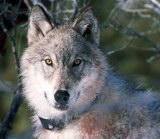 Wolves WolvesWolf History, Conservation, Ecology and Behavior
[www.wolfology.com]
|
Use of Selection Indices to Model the Functional Response of Predators
Jolly, Damien O.; Patterson, Brent, Ecology, 84/6 (June 2003), 1635 (6pp)
The functional response of a predator to changing prey density is an important determinant of stability of predator-prey systems. We show how Manly's selection indices can be used to distinguish between hyperbolic and sigmoidal models of a predator functional response to primary prey density in the presence of alternative prey. Specifically, an inverse relationship between prey density and preference for that prey results in a hyperbolic functional response while a positive relationship can yield either a hyperbolic or sigmoidal functional response, depending on the form and relative magnitudes of the density-dependent preference model, attack rate, and handling time. As an example, we examine wolf (Canis lupus) functional response to moose (Alces alces) density in the presence of caribou (Rangifer tarandus). The use of selection indices to evaluate the form of the functional response has significant advantages over previous attempts to fit Hollings functional response curves to killing-rate data directly, including increased sensitivity, use of relatively easily collected data, and consideration of other explanatory factors (e.g., weather, seasons, productivity).
 Using Faecal DNA Sampling and GIS to Monitor Hybridization between Red Wolves (Canis rufus) and Coyotes (Canis latrans)
Adams, J.R.; Kelly, B.T.; Waits, L.P., Molecular Ecology, 12/8 (August 2003), 2175 (12pp)
The US Fish and Wildlife Service's (USFWS) Red Wolf Recovery Program recognizes hybridization with coyotes as the primary threat to red wolf recovery. Efforts to curb or stop hybridization are hampered in two ways. First, hybrid individuals are difficult to identify based solely on morphology. Second, managers need to effectively search 6000 km2 for the presence of coyotes and hybrids. We develop a noninvasive method to screen large geographical areas for coyotes and hybrids with maternal coyote ancestry by combining mitochondrial DNA sequence analyses of faeces (scat) and geographic information system (GIS) technology. This method was implemented on the Alligator River National Wildlife Refuge (1000 km2) in northeastern North Carolina. A total of 956 scats were collected in the spring of 2000 and 2001 and global positioning system (GPS) coordinates were recorded. Seventy-five percent of the scats were assigned to species and five coyote/hybrid scats were detected. Placement of scat location coordinates on a map of the experimental population area revealed that four of the coyote/hybrid scats were detected within the home ranges of sterilized hybrids. The other coyote/hybrid scat indicated the presence of a previously unknown individual. We suggest this method be expanded to include more of the experimental population area and be optimized for use with nuclear markers to improve detection of hybrid and back-crossed individuals.
 Validating Measures of Ecological Integrity for Wolves in Protected Areas
Pisapio, John; Patterson, Brent, World Wolf Congress 2003
Ecological integrity is the conservation principle underlying the management of ecosystems anchored within large parks and protected areas. The presence of keystone species such as wolves is recognized as a measure or indicator of ecological integrity. However, the occurrence of a species satisfies only one of three fundamental attributes of ecosystems, the other two being structure and function. Structural demographics and non-demographic ecological responses in wolves may reflect relative levels of annual mortality. Despite this, measures of wolf population structure and ecological responses to human exploitation are rarely incorporated into management strategies. Human-caused mortality of park wolves beyond park boundaries is generally considered inconsequential so long as the threshold of compensatory mortality is not exceeded. This reflects a narrow view of population integrity or health based exclusively on whether numbers are increasing, decreasing or are stable. In this paper, we consider whether this view is incongruous with the priority conservation objectives of protected areas. Trans-boundary movements of wolves from Algonquin Provincial Park, Ontario, and associated human-caused mortality are discussed within the context of what defines "protection" for a portion of a wolf population. This discussion is intended to provide a basis for developing further research on wolves needed to validate measures of ecological integrity.
|
